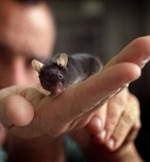 |
| Dr
Robert Kapsa has reversed muscular dystrophy in mice cells. Now
to treat humans who have the disorder. Picture: HEATH MISSEN |
| Melbourne find on dystrophy |
|
Melbourne researchers have corrected the genetic defect that causes muscular dystrophy.
In the groundbreaking discovery at St Vincent's Hospital, researchers from the hospital's Melbourne Neuromuscular Research Institute experimented on mice. By inserting normal mouse DNA into muscular dystrophy-affected mouse cells they found they could correct the genetic defect.
The leader of the research team, Dr Robert Kapsa, said that once the technique was refined it held great promise for treating Duchenne muscular dystrophy and other muscular dystrophies by repairing the gene within the cells of people with the condition.
The aim of the research was to help people who are living with muscular dystrophy now, a goal that would be reached more quickly with increased funding and greater interest from researchers, he said.
"Muscular dystrophy affects one in 2500 boys," Dr Kapsa said. "They are diagnosed at three, wheelchair-bound at seven or eight and spend the rest of their lives in an electric wheelchair. They die, on average, by age 22 and die because their muscles waste away."
Duchenne muscular dystrophy results from mutations in the dystrophin gene, which is found on the X chromosome.
Patients' muscles waste away because they lack the protein dystrophin that maintains the structure of muscle.
The dystrophin gene is very large and mutations occur at a number of different sites in the gene. The site of the mutation determines the severity of the muscular dystrophy. The number of different mutations that lead to the condition is unknown but could be in the hundreds.
Dr Kapsa and his colleagues have spent about 18 months studying dystrophin gene mutations and trying to reverse them in mouse cells. They have also had some success repairing the gene mutation in the leg muscles of a muscular dystrophy-affected mouse.
But to date, the cell experiments have shown the most promise. In these experiments the researchers introduced a normal copy of the dystrophin gene into mouse cells that carried the defective gene. Via a process called homologous recombination 15 to 20 per cent of these cells were able to be converted from containing the muscular dystrophy gene to the normal gene. The research will be published in the journal Human Gene Therapy in April.
Homologous recombination has also been investigated as a way to correct the genetic defects that lead to cystic fibrosis but in this case only about 1per cent of cells with the defect were corrected. "What we are aiming to do is generate cultures of stem cells (cells that can develop into any part of the human body) that are genetically corrected and then use them for transplantation in individuals with Duchenne dystrophy," Dr Kapsa said. "Cells, such as bone marrow stem cells, could be obtained from an individual with Duchenne muscular dystrophy and the mutation in these cells could be repaired. These genetically corrected cells could then be returned to the patient, minimising the chance of immune rejection, and then induced to repopulate the muscle."
There are three stages to the work: repairing the genetic mutation, getting these cells into the bodies of mice (and ultimately humans), and getting corrected cells into affected muscles.
The first stage is accomplished, although the researchers need the genetic defect to be corrected in 100 per cent of cells rather than 15 to 20 per cent. The second stage has also been achieved; the researchers have put normal mouse bone marrow cells into a mouse with muscular dystrophy. And, encouragingly, the third stage of getting the normal cells into affected muscle has also been reached, although only a small proportion of these cells have reached the muscle so far.
![]()